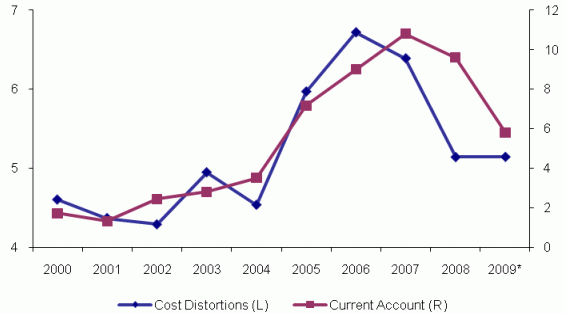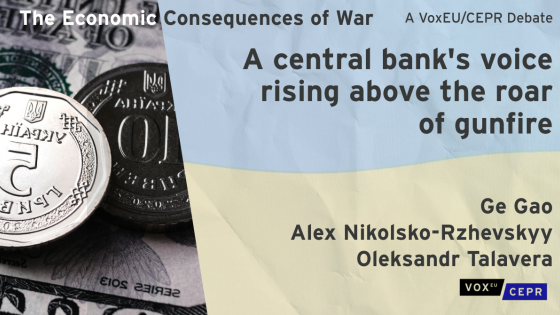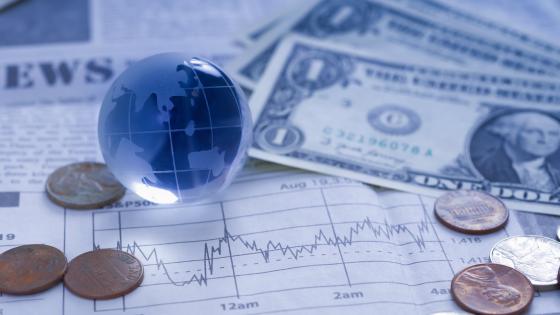China’s current-account surplus has been a subject of contentious international economic policy debate for several years. But while politicians in other countries often criticise China’s rigid exchange-rate regime, their real target is probably not the exchange-rate policy per se but China’s external imbalances. It has been argued that, by running a large current-account surplus, China has caused job losses in its trading partners (Krugman 2010). Recently, US politicians have escalated pressure on China to appreciate the renminbi.
Most Chinese economists and officials strongly reject the claim that China and its exchange-rate policy were to blame for America’s asset bubbles, high unemployment rate, and large current-account deficits. Indeed, the US began to lose manufacturing jobs well before China emerged as the global manufacturing centre earlier this decade. Indeed, America’s current-account deficits started to expand rapidly in the late 1990s, but the surge of China’s current-account surplus occurred after 2004. Blaming China for causing America’s economic problems appears at odds with common sense (Huang 2010).
But these facts do not mean China’s large and growing external imbalances are not problematic. Persistent current-account surpluses mean that, as a low-income economy, China exports capital to rich countries. Rising external surpluses often worsen China’s trading relations with its major trading partners and, therefore, threaten its growth sustainability. Heavy intervention in foreign-exchange markets leads to massive liquidity in the market, which adds to inflation pressure. And, finally, rapid accumulation of foreign-exchange reserves also made China vulnerable in face of US dollar adjustment (Yu 2007).
It should be in China’s own interest to rebalance the external sector. But how can China effectively reduce its current-account surplus? Since 2003, the Chinese government has been trying to narrow external surpluses through measures such as modest appreciation of the currency and reductions of export tax rebates. Unfortunately, the current-account surplus rose steadily from 2.8% of GDP in 2003 to 10.8% in 2007, before moderating to 9.6% in 2008 due to the shocks of the global crisis.
Six explanations offered by existing literature
The literature has provided six competing explanations for China’s large current-account surplus, especially its recent surge.
- The first hypothesis relates to capital inflows disguised as a current-account surplus. In fact, the rapid growth of the current-account surplus coincided with appreciation of renminbi in 2005, which probably encouraged the expectation of further appreciation, as evidenced by changes in non-deliverable forward market rates. Some economists have estimated that this inflated the current-account surpluses in 2005-07 by around 3 percentage points (Zhang 2009).
- The second hypothesis focuses on China’s unique saving behaviour. Many economists explain the high saving rate of the Chinese households by reference to cultural factors of East Asia and underdeveloped social welfare systems. More recently, however, attention has shifted toward rapidly growing corporate savings in China, which were about 22.9% of GDP in 2007, roughly doubling their share in 1992 (Zhou 2009). Therefore, China may need to increase the investment rate, in addition to lowering the saving rate, so as to reduce its current-account surplus.
- The third hypothesis focuses on the role of the demographic transition. China has been implementing a family-planning policy since the 1970s. After thirty years, the youth dependency ratio dropped rapidly, generating what some economists called “population dividend”. This probably affected the saving behaviour of the population. Some economists found that decline in youth dependency ratio by nearly 20 percentage points contributed to rise of China’s net foreign asset position by 90% of GDP (Ma and Zhou 2009).
- The fourth hypothesis identifies migration of manufacturing factories to China in recent years, together with their trade surpluses. After its WTO accession in late 2001, China quickly became the global manufacturing centre. This helped to shift the supply chains of some sectors, such as the technology industry, into China. Since China still imports substantial amounts of intermediate goods from other Asian countries, in a way China exports to the US and other advanced economies on behalf of Asian economies. This is evidenced by the fact that China’s rising bilateral trade surplus with the US parallels its growing bilateral trade deficits with other Asian economies.
- The fifth hypothesis singles out the importance of China’s policies promoting strong economic growth. The Chinese government always attaches great importance to GDP growth, out of its concerns for job creation. As the reform architect Deng Xiaoping once claimed “development is a hard principle”. GDP growth is the utmost policy goal for governments at all levels. When so many goods are produced they are destined for foreign markets, since domestic consumption remain relatively weak (Corden 2009).
- And, finally, the last hypothesis concerns the impact of the exchange-rate policy. Although there is disagreement on the degree of exchange-rate distortion, economists generally agree that the currency is probably undervalued (Goldstein and Lardy 2009). An undervalued currency could plausibly cause a current-account surplus, since a depressed exchange rate encourages exports and discourages imports.
All these explanations suggested by the literature appear to be reasonable. But only the first hypothesis (disguised capital inflows) and the fourth hypothesis (migration of surpluses) help to account for the recent surge of China’s current- account surpluses. For instance, while bilateral exchange rates are an important factor behind the external imbalance, it is difficult to explain co-existence of both appreciating renminbi and widening current-account surpluses in 2005-08.
An additional hypothesis: Factor-cost distortion
Here I propose an additional hypothesis for China’s external imbalances: asymmetric market liberalisation and factor-cost distortion. The central theme of China’s more than thirty years’ programme of economic reform has been to re-introduce market mechanisms. The process of market-oriented reform, however, has been asymmetric. Goods markets have almost been completely liberalised, which allows China to exploit its comparative advantage in abundant labour and to gradually improve productive efficiency (Lin et al. 1995).
Meanwhile, factor markets remain heavily distorted. In the labour market, the household registration system still discourages labour mobility within China. It can no longer prevent farmers from finding jobs in the cities, but it still creates significant institutional discrimination against migrant workers. Those migrant workers cannot settle permanently in the cities and are not entitled to the urban social welfare benefits. Such discrimination help repress wages of migrant workers.
Capital markets still show clears symptoms of financial repression, evidenced by highly regulated interest rates and frequent state intervention in credit allocation. These problems, together with stricter controls over capital outflows than those over capital inflows, probably push down the cost of capital. The undervalued currency is yet another example of a policy creating a distortion in capital costs.
Land is owned by the state in the cities and by rural collectives in the countryside. Although land prices skyrocketed recently for property developments, land use costs remain extremely low for manufacturing investors. Often local governments compete with each other by offering lower land prices in order to attract outside investors. A mismatch clearly exists.
Distortions to prices of energy and other resources are commonly observed in China. In 2008, at the peak of the international oil prices at $150 per barrel, domestic equivalent prices were only at around $80 per barrel. Water, gas, and electricity are also exceedingly cheap, compared with international prices.
Some of these distortions, such as energy cost distortion, are the result of government’s deliberate policy choices. Others, such as capital cost distortion, are transitional phenomenon during the reform period. But cost distortion is not an entirely new phenomenon in China. During the pre-reform period, the government also depressed agricultural prices in order to channel funds into the urban industry. The purpose of such policy is to achieve fastest possible economic growth.
All these distortions share a common effect, i.e. repressing factor costs. With co-authors, I have made some efforts to estimate the magnitudes of such factor-cost distortions for 2000-2009 (Huang and Tao 2010). Estimates of the distortions to the cost of capital are by far the largest component, ranging from 3% to 4% of GDP. Labour-cost distortions have increased significantly in recent years, more because of the slower growth of migrant workers’ pay than urban wages. Distortions to both land and energy costs showed upward trends during the past years.
Such distortions to factor costs are equivalent to producer subsidies. They artificially raise the profitability of production, increase returns to investment, and improve the competitiveness of Chinese exports in international markets. They also contributed to China’s extraordinary GDP growth. At the same time they also led to serious external imbalances, since investment and exports levels were even higher than otherwise. Meanwhile, factor cost distortions also lowered the share of household income in GDP by at least 10 percentage points during the past decade. This, in turn, had negative effects on the share of GDP devoted to consumption expenditures.
In fact, movement of the combined cost distortions for capital, land, and energy provides a reasonable explanation about recent surge in current-account surplus. In Figure 1, I have deliberately left out the impact of labour-cost distortions since the robustness of the empirical estimates of these distortions are often challenged. Adding back labour-cost distortion, however, does not change the picture at all. I conclude that factor-cost distortion is at least one important plausible factor behind China’s large recent increase in its current-account surplus.
Figure1. Estimated cost distortion excluding labour cost and the Chinese current-account balance, 2000-09 (% GDP)
Source: CEIC Data Company and authors’ estimation.
Rebalancing the Chinese economy requires a comprehensive package
So what are the implications for the current policy debate on China’s external imbalances? The most important lesson is that China’s large current-account surpluses are probably caused by a number of factors. Therefore, effectively addressing this problem will require a comprehensive policy package. Exchange-rate policy should be an important part of this package so that the adjustment is smooth and orderly. Yet, an exclusive focus on the value of the bilateral exchange rate could be counter-productive.
This idea of comprehensive policy package dealing with China’s external imbalance is already shared by many American economists. Goldstein and Lardy (2009), for instance, have proposed a four-part package relating to fiscal, financial, exchange rate, and price policies. Likewise, Woo (2006) has argued that trade surpluses are better handled by the establishment of an efficient financial intermediation mechanism than by appreciation of the currency.
My analysis suggests that a key element of the policy package should be the liberalisation of the factor markets and the removal of associated cost distortions. Only by reducing the latter will the incentives for exports and imports change, which would in turn affect the external imbalances. Exchange-rate policy should be a part, but not the whole, of this package.
References
Corden. W Max (2009), “China’s Exchange Rate Policy, Its Current Account Surplus and the Global Imbalances”. in Ross Garnaut, Ligang Song and Wing Thye Woo (eds), China’s New Place in a World in Crisis. ANU E-Press, Canberra, Australia, and Brookings Institution, Washington D.C.
Goldstein, Morris and Nicholas R Lardy (2009), The Future of China’s Exchange Rate Policy, Peterson Institute for International Economics, Washington D.C.
Huang, Yiping (2010), “Krugman’s Chinese Renminbi Fallacy”, VoxEU.org, 26 March.
Huang, Yiping and Kunyu Tao (2010), “Causes and Remedies of China’s Current Account Surpluses”, CCER Working Paper 2010002, 25 February, China Center for Economic Research, Peking University, Beijing.
Krugman, Paul (2010), “Chinese New Year”, New York Times, 1 January.
Lin, Justin Yifu (2010), “Dealing with Global Imbalances”, presentation at the KDI/IMF conference “Reconstructing the World Economy”, Seoul, Korea, 25 February.
Lin, Justin Yifu, Cai Fang, and Li Zhou (1995), The China Miracle: Development Strategy and Economic Reform, The Chinese University of Hong Kong Press, Hong Kong.
Ma, Guonan and Haiwen Zhou (2009), “China’s Increasing External Wealth”, Chapter 4 in Ross Garnaut, Ligang Song and Wing Thye Woo (eds.), China’s New Place in a World in Crisis, ANU E-Press, Canberra and Brookings Institution, Washington D.C.
Woo, Wing Thye (2006), “The Structural Nature of Internal and External Imbalances in China”, Journal of Chinese Economic and Business Studies, 4(1): 1- 19.
Yu, Yongding (2007), “Global Imbalances and China”, Australian Economic Review, 40(1):1-33.
Zhang Zhiwei (2009), “Dark Matters in China’s Current Account”, Paper presented at the China Economist Society Conference on Greater China Economic Integration, 30-31 March.
Zhou Xiaochuan (2009), “Thoughts on Saving Rate”, Essay published on the official website of the People’s Bank of China, Beijing, China, 24 March.



